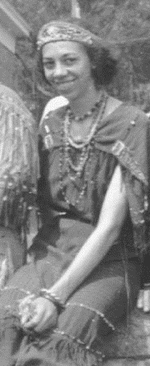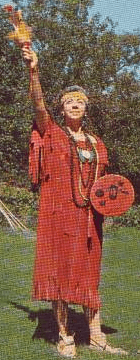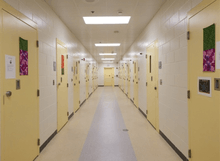Zara Cisco Brough
Zara Cisco Brough (1919–1988), often spelled as Zara Ciscoe Brough, commonly referred to as Princess White Flower, served as the Chief of the Nipmuc Native Indian Tribe for 25 years from 1962 until 1987. She is best known for her work to preserve Nipmuc heritage, especially her letter of intention to petition for federal recognition of the Nipmuc as a legally distinct Native American people, which resulted in the Nipmuc being placed on "active consideration" for the status of Federally recognized tribe by 11 July 1995.
Zara Cisco Brough | |
|---|---|
Princess White Flower | |
 | |
| Nipmuc leader | |
| Preceded by | Sarah Cisco Sullivan |
| Personal details | |
| Born | January 3, 1919 New York City |
| Died | January 7, 1988 (aged 69) Massachusetts |
| Cause of death | Parkinson's disease |
During her lifetime she worked as an electronics engineer, fashion designer, drafter, technical writer, and supervisor of government projects. She held the post of "State commissioner for Indian Affairs" from 1974 to 1984. On January 7, 1988, Brough died at a Westborough, Massachusetts nursing home from Parkinson's disease at the age of 68.[1][2][3]
In January 2009 a Department of Youth Services facility located at 288 Lyman Street in the town of Westborough was formally named as the Zara Cisco Brough "Princess White Flower" Facility through the House Bill 3231. It had previously been named thus in 2007 but the official act was passed in 2009.[4][5]
Ancestry and childhood
Zara Cisco Brough was born in 1919 in New York City, New York. She was the daughter of Sarah Cisco Sullivan and the granddaughter of James Lemuel Cisco. Her ancestry is traced back to William of Sudbury (1596–1676) who was also known by the names Naaos, Naoas and Nataous. He served as a deacon in the native church at Hassanamesit which later came to be known as Grafton. According to the account by Richard W. Cogley in the New England Historical and Genealogical Register, William of Sudbury fathered four sons, one of whom was James the Printer (died 1712) who worked as a typesetter in Cambridge, Massachusetts and credited for his assistance in the Algonquin language Eliot Indian Bible, the first translation of the Bible into a native language. Sarah Cisco is descended from James the Painter.[2][6][7]
Brough was the daughter of Sarah Ciscoe Sullivan and Charles Brough. Brough's grandfather Chief James Lemeul Ciscoe, was officially entitled Chief of the Hassanamisco Nipmuc, and her great-grandfather Samuel C. Cisco was a Chief of the Narragansett people.[2][8] Her mother, Sara Ciscoe Sullivan was also a Chief the Nipmuc nation.[9] Zara Cisco Brough spent her childhood at the Hassanamisco Indian reservation in Grafton, Massachusetts. According to her own account her interest in native Indian cultural heritage and history was sparked by her grandfather, who used to tell her about tribal traditions and rituals during her childhood. Brough received her primary education from the Grafton school system.[7]
Early career
Brough attended engineering college in Washington D.C and went on to take special courses at the New York University, New York. She took up residence after completing her course and, working as a draftsperson, fashion designer, technical writer and supervisor of government projects. She also co-owned a textile printing company during her stay in Washington D.C.[10]
Brough served as a civilian consultant to the Army Air Corps during World War II. In recognition of her work the United States Air force awarded her the United States Air Force Award of Superior Performance.
Return home
In 1959 she left New York to return home to take care of her ageing mother. After her arrival, Brough accepted the job of vice president of the former Ibis Corporation located in Waltham, Massachusetts, which specialized in electronic and environmental consultation.[11]
Position as chief and political advocacy

Having returned to her ancestral home she sought involvement in activist and political organizations. In the coming years she worked in defence of the Nipmuc nation from cultural and historical dissolution. Brough was named tribal Chief of the Nipmuc people in 1959. In 1962 she founded the Hassanamisco Museum which was nicknamed "Memorial to the Eastern American Indian" to document and preserve Nipmuc heritage. The mission of the museum has now extended to include historical preservation of hundreds of other Native Indian tribes. The Hassanamisco Museum contains displays of artefacts, manuscripts, crafts, tribal specific legends and news clippings pertaining to the Indian tribes.[12] She was also responsible for the acquisition of dredging rights to Lake Ripple on behalf the Nipmuc Nation.[13][14]
Brough also played a leading role in establishing the Massachusetts Commission on Indian Affairs, which was created in 1974 and officially recognized by the state of Massachusetts in 1976. Being a founding member of the commission, she was nominated for the position of Commissioner of Indian Affairs, a post which she held for 18 years from 1976 till 1984. During her tenure as the commissioner, she successfully lobbied to amend the charter of the Hassanamisco Foundation. According to the new amendments, federally recognized Nipmuc reservation lands will never leave Nipmuc hands even if the Cisco bloodline comes to an end. The Cisco Homestead was also later recognized as an endangered historic resource and came under federal protection in 2009.[15][16] Brough was actively involved in the Council of New England Indians. She organized the Council and established the Nipmuc branch of the council.[17]
Brough served on the Grafton Planning Board and Central Massachusetts Planning Board, and was involved in a number of other organizations such as the Grafton Forest Association, the Framingham Historical Society, the National Geographic Society, the Natural History Museum of New York, Mendon Historical Society, National Congress of American Indians, Technical Writers and Publishers Society, Worcester Art Museum, the Board of Trustees of the Riverside, Old and Indian Cemeteries, Grafton Taxpayers Association and the Grafton Player's Club.[18][7] In addition to her involvement with numerous committees she chaired the board of directors of the Hassanamisco Reservation Foundation Trust, which works to promote and ensure preservation of Nipmuc tribal lands and heritage.[19]
Career as an author
In addition to her career as a consultant and position of leadership as Chief of the Nipmuc Nation, Zara Cisco Brough was a published writer. Brough, in her capacity as an electronics engineer, worked in collaboration with Vance Parker and Brent Haslam and published research detailing theoretical applications of "Pattern Ratio Technique" to arrays. The findings were published in a 1969 scholastic issue of Defense Technical Information Center.[20][21]
Her non-scientific published works include Native American poetry, retellings of the history of the Nipmuc nation and books of Nipmuc recipes. For her committed involvement with the community she was awarded the Camp-fire Girls Certificate of Appreciation of Outstanding Service in 1970.
Legacy

She is well known for her work to preserve Nipmuc heritage. Her most renowned effort is a petition for Nipmucs to be granted the status of one of the Federally recognized tribes of the Native American peoples. This resulted in the Nipmuc being placed on "active consideration" for federal recognition by 11 July 1995. Although the tribe gained state recognition, they were denied federal recognition.[22]
In recognition of her efforts for the betterment of the community a Massachusetts Department of Youth Services Facility located at 288 Lyman Street, Westborough was formally named as the Zara Cisco Brough "Princess White Flower" Facility through the House Bill 3231 in 2009. It had previously been named thus in 2007 but the official act was passed in 2009.[4][5]
References
- "Zara Brough, designer, Indian Chief". chicagotribune. chicagotribune. 10 January 1988. Retrieved 20 April 2015.
- "National Register of Historic Places Registration Form" (PDF). National Park Service. United States Department of the Interior. Retrieved 14 April 2015.
- "Fashion Designer who was Indian chief dies". The Tuscaloosa News. The Tuscaloosa News. 10 January 1988. Retrieved 20 April 2015.
- Keenan, Kevin (6 January 2007). "Lockup to meet needs of girls". TELEGRAM. Retrieved 20 April 2015.
- "House bill naming new Youth Services facility passes". wickedlocal. 8 January 2009. Retrieved 20 April 2015.
- Wiser, Ron. "WISER NEWSLETTER RESEARCH FINDINGS". Retrieved 20 April 2015.
- "Candidate for Planning board". freepages. Retrieved 21 April 2015.
- Senier, Siobhan. Dawnland Voices. United States of America: Board of Regents of the University of Nebraska. pp. 378–381.
- Harkin, M. E. (2004). Reassessing revitalization movements: Perspectives from north america and the pacific islands. (p. 265-267). Lincoln, NE: University of Nebraska Press.
- "New DYS facility named for former Nipmuc chief". CommunityAdvocate. 27 July 2007. Retrieved 21 April 2015.
- "A former electronics engineer". orlandosentinel. orlandosentinel. 9 January 1988. Retrieved 21 April 2015.
- "Hassanamisco Indian Museum". nipmucmuseum. Retrieved 21 April 2015.
- Senier, Siobhan. Dawnland Voices: An Anthology of Indigenous Writing from New England. U of Nebraska Press. ISBN 9780803256804. Retrieved 21 April 2015.
- "A Brief Look at Nipmuc History". nipmuc nation. Retrieved 21 April 2015.
- Senier, Siobhan. Dawnland Voices: An Anthology of Indigenous Writing from New England. U of Nebraska Press. ISBN 9780803256798. Retrieved 21 April 2015.
- "Endangered resources 2009" (PDF). preservationmass.org. Retrieved 21 April 2015.
- Malinowski, Sharon. The Gale Encyclopedia of Native American Tribes: Northeast, Southeast, Caribbean, Volume 1. University of California. p. 185. ISBN 9780787610869. Retrieved 21 April 2015.
- "Zara Cisco Brough Obituary". freepages. Retrieved 2 Nov 2016.
- Scheirbeck, HM. "Report on Indian Education—Task Force Five:" (PDF). Retrieved 21 April 2015.
- Haslam, Brent; Parker, Vance; Brough, Zara (1969). ANTENNA ARRAY ELEMENT STUDY. Defense Technical Information Center. Retrieved 21 April 2015.
- U.S. Government Research & Development Reports, Volume 69, Issues 19–24. Pennsylvania: U.S. Government Printing Office. p. 87. Retrieved 21 April 2015.
- Murphy, Sean (19 June 2004). "2 Indian groups are denied tribal status". boston.com. boston globe. Retrieved 21 April 2015.